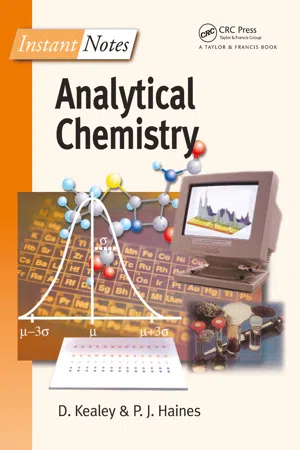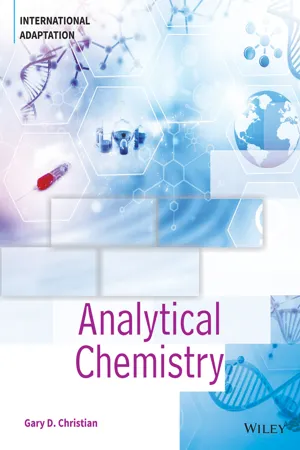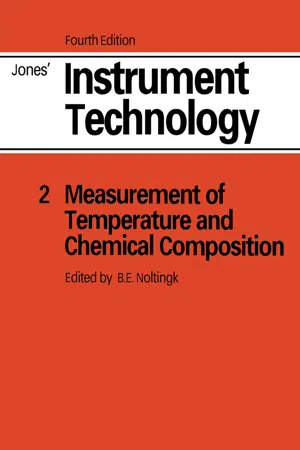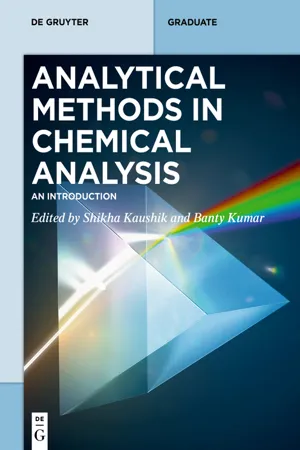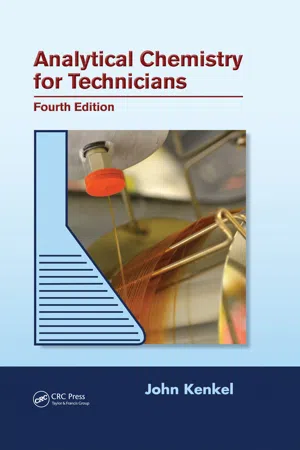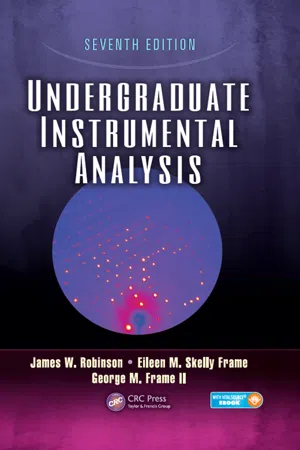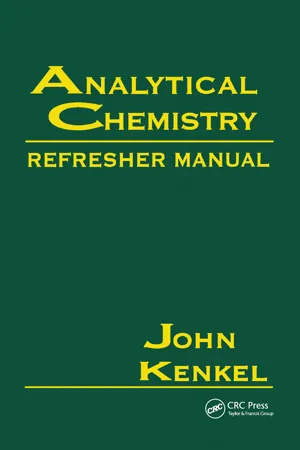Chemistry
Chemical Analysis
Chemical analysis involves the techniques and methods used to identify and quantify the components of a substance. It encompasses a wide range of analytical techniques such as spectroscopy, chromatography, and mass spectrometry. The goal of chemical analysis is to understand the composition and properties of substances, which is essential for various scientific and industrial applications.
Written by Perlego with AI-assistance
Related key terms
1 of 5
12 Key excerpts on "Chemical Analysis"
- eBook - ePub
- David Kealey, P J Haines(Authors)
- 2004(Publication Date)
- CRC Press(Publisher)
Section A – The nature and scope of analytical chemistry
A1 ANALYTICAL CHEMISTRY, ITS FUNCTIONS AND APPLICATIONS
Key Notes
Analytical chemistry is a scientific discipline used to study the chemical composition, structure and behavior of matter.The purpose of Chemical Analysis is to gather and interpret chemical information that will be of value to society in a wide range of contexts.Quality control in manufacturing industries, the monitoring of clinical and environmental samples, the assaying of geological specimens, and the support of fundamental and applied research are the principal applications.Related topics
Analytical problems and procedures (A2) Chemical sensors and biosensors (H1) Automated procedures (H2) Computer control and data collection (H3) Data enhancement and databases (H4)Definition
Analytical chemistry involves the application of a range of techniques and methodologies to obtain and assess qualitative, quantitative and structural information on the nature of matter.- Qualitative analysis is the identification of elements, species and/or compounds present in a sample.
- Quantitative analysis is the determination of the absolute or relative amounts of elements, species or compounds present in a sample.
- Structural analysis is the determination of the spatial arrangement of atoms in an element or molecule or the identification of characteristic groups of atoms (functional groups).
- An element, species or compound that is the subject of analysis is known as an analyte.
- The remainder of the material or sample of which the analyte(s) form(s) a part is known as the matrix.
Purpose
The gathering and interpretation of qualitative, quantitative and structural information is essential to many aspects of human endeavor, both terrestrial and extra-terrestrial. The maintenance of, and improvement in, the quality of life throughout the world, and the management of resources rely heavily on the information provided by Chemical Analysis. Manufacturing industries use analytical data to monitor the quality of raw materials, intermediates and finished products. Progress and research in many areas is dependent on establishing the chemical composition of man-made or natural materials, and the monitoring of toxic substances in the environment is of ever increasing importance. Studies of biological and other complex systems are supported by the collection of large amounts of analytical data. - eBook - ePub
Environmental Chemistry
Eleventh Edition
- Stanley E Manahan, Stanley E. Manahan(Authors)
- 2022(Publication Date)
- CRC Press(Publisher)
24 Chemical Analysis in Environmental and Toxicological ChemistryDOI: 10.1201/9781003096238-2424.1 Analytical Chemistry
Analytical chemistry is that branch of the chemical sciences employed to determine the composition of a sample of material. A qualitative analysis is performed to determine what is in a sample. The amount, concentration, composition, or percentage of a substance present is determined by quantitative analysis. Often, both qualitative and quantitative analyses are performed as part of the same process.Analytical chemistry is important in practically all areas of human endeavor and in all spheres of the environment. Industrial raw materials and products processed in the anthrosphere are assayed by Chemical Analysis, and analytical monitoring is employed to monitor and control industrial processes. Hardness, alkalinity, and trace-level pollutants (see Chapters 2 –7 ) are measured in water by chemical analyses. Nitrogen oxides, sulfur oxides, oxidants, and organic pollutants (see Chapters 9 –12 ) are determined in air by Chemical Analysis. In the geosphere (see Chapters 13 –15 ), fertilizer constituents in soil and commercially valuable minerals in ores are measured by Chemical Analysis. In the biosphere, xenobiotic materials and their metabolites (see Chapters 22 and 23 ) are monitored by Chemical Analysis. Analytical chemistry is very important in the area of occupational health and the practice of industrial hygiene.Analytical chemistry is a dynamic discipline. New chemicals and increasingly sophisticated instruments and computational capabilities are constantly coming into use to improve the ways in which chemical analyses are done. Some of these improvements involve the determination of ever smaller quantities of substances; others simplify the procedures for analysis, greatly shortening the time required for analysis; and some enable analysts to tell with much greater specificity the identities of a large number of compounds in a complex sample. - eBook - PDF
- Gary D. Christian, Purnendu K. Dasgupta, Kevin A. Schug(Authors)
- 2020(Publication Date)
- Wiley(Publisher)
One suggestion is that we use the term analytical science and technology (Reference 3). The Federation of European Chemical Societies held a contest in 1992 to define analytical chemistry, and the following suggestion by K. Cammann was selected [Fresenius’ J. Anal. Chem., 343 (1992) 812–813]. Analytical Chemistry provides the methods and tools needed for insight into our material world . . . for answering four basic questions about a material sample: What? Where? How much? What arrangement, structure or form? These cover qualitative, spatial, quantitative, and speciation aspects of analyti- cal science. The Division of Analytical Chemistry of the American Chemical Society developed a definition of analytical chemistry, reproduced in part here: Analytical Chemistry seeks ever improved means of measuring the chemical com- position of natural and artificial materials. The techniques of this science are used to identify the substances which may be present in a material and to determine the exact amounts of the identified substance. Analytical chemists serve the needs of many fields: In medicine, analytical chemistry is the basis for clinical laboratory tests which help physicians diagnose disease and chart progress in recovery. In industry, analytical chemistry provides the means of testing raw materials and for assuring the quality of finished products whose chemical compo- sition is critical. Many household products, fuels, paints, pharmaceuticals, etc. are analyzed by the procedures developed by analytical chemists before being sold to the consumer. Environmental quality is often evaluated by testing for suspected contami- nants using the techniques of analytical chemistry. The nutritional value of food is determined by Chemical Analysis for major components such as protein and carbohydrates and trace components such as vitamins and minerals. Indeed, even the calories in food are often calcu- lated from its Chemical Analysis. - eBook - PDF
- L. Pataki, E. Zapp, R. Belcher, D Betteridge, L Meites(Authors)
- 2013(Publication Date)
- Pergamon(Publisher)
Chapter 3 Quantitative Chemical Analysis Scientific research work and industrial production control are based on accurate numerical data concerning the composition of materials. These data are usually determined by the methods of quantitative Chemical Analysis. Even such diverse fields as preparative organic and inorganic chemistry, geology or biology require the analysis of pro-cesses or materials in order to interpret reaction mechanisms, the pro-cesses taking place in geological layers or in the living organism. In-dustrial raw materials, as well as the end products, are increasingly often characterized by fast, semiautomatic or fully automated analyt-ical techniques, by which the problem is reduced to simple routine measurements. Thus, should a particular problem of composition occur, the theoretical or practical chemist, biochemist or geologist must be able to apply or recommend an appropriate method for the analysis of the components, including the impurities, of the sample. They must also be acquainted with the underlying concepts of analyt-ical methods, the performance, limitations, accuracy, precision and speed of a given measurement. When approaching a particular analytical problem, the following considerations are relevant: (i) The type of analysis required: elemental, molecular, function-al group, etc; (ii) The concentration range of the components; (iii) The accuracy required; (iv) The time allotted; (v) Interfering effects; (vi) The physical and chemical behaviour of the components; (vii) The chemicals and equipment available; (viii) Economic aspects, such as manpower, costs and financial resources. It can be seen that no ideal method exists which meets every re-quirement. It is to be stressed that accuracy must not be overrated at the expense of speed. Owing to the complex composition of samples from natural sources, simpler methods are often more reasonable to apply. - eBook - ePub
- Walt Boyes(Author)
- 2009(Publication Date)
- Butterworth-Heinemann(Publisher)
Chapter 22. Chemical Analysis IntroductionW.G. Cummings and I. Verhappen
22.1. Introduction to Chemical Analysis
In the early 20th century, analytical chemistry depended almost entirely on measurements made gravimetrically and by titrimetry, and students were taught that the essential steps in the process were sampling, elimination of interfering substances, the actual measurement of the species of concern, and finally, the interpretation of results. Each step required care, and often substances were analyzed completely so that the components could be checked to total to within an acceptable reach of 100 percent.Classical analytical methods are still used from time to time, generally for calibrating instruments, but during the past 40 years, the analytical chemistry scene has changed considerably. Spectroscopy and other physical methods of analysis are now widely used, and a comprehensive range of chemical measuring instruments has been developed for specific techniques of analysis. This has meant that Chemical Analysis is now carried out as a cooperative effort by a team of experts, each having extensive knowledge of their own specialist technique, such as infrared absorption, emission spectrography, electrochemistry, or gas chromatography, while also having considerable knowledge of the capabilities of the methods used by other members of the team.Thus the analytical chemist has become more than just a chemist measuring the chemical composition of a substance; he is now a problem solver with two more steps in the analytical process—one at the beginning (definition of the problem) and another at the end (solution to the problem). This means that the analytical chemist may measure things other than narrowly defined chemical composition—she may decide, for example, that pH measurements are better than analysis of the final product for controlling a process, or that information on the valency states of compounds on the surface of a metal is more important than determining its composition. - eBook - PDF
Measurement of Temperature and Chemical Composition
Jones' Instrument Technology
- B E Noltingk(Author)
- 2013(Publication Date)
- Butterworth-Heinemann(Publisher)
2 Chemical Analysis - introduction W. G. CUMMINGS 2.1 Introduction to Chemical Analysis Fifty years ago analytical chemistry depended almost entirely on measurements made gravimetrically and by titrimetry and students were taught that the essential steps in the process were sampling, elimination of interfering substances, the actual measurement of the species of concern and finally the interpretation of results. Each step required care, and, often, substances were analysed completely so that the components could be checked to total to within an acceptable reach of 100 per cent. Classical analytical methods are still used from time to time, generally for calibrating instruments, but during the last thirty years the analytical chemistry scene has changed considerably. Spectroscopy and other physical methods of analysis are now widely used and a comprehensive range of chemical measuring instruments has been developed for specific techniques of analysis. This has meant that Chemical Analysis is now carried out as a cooperative effort by a team of experts, each having extensive knowledge of his own specialist technique, e.g. infrared absorption, emission spectrography, electrochemistry, gas chromatography, while also having considerable knowledge of the capabilities of the methods used by other members of the team. Thus the analytical chemist has become more than just a chemist measuring the chemical composition of a substance; he is now a problem solver with two more steps in the analytical process - one at the beginning, 'definition of the problem', and another at the end, 'solution to the problem'. This means that the analytical chemist may measure things other than narrowly defined chemical composition - he may decide, for example, that pH measurements are better than analysis of the final product for controlling a process or that information on the valency states of compounds on the surface of a metal is more important than determining its composition. - eBook - ePub
Analytical Methods in Chemical Analysis
An Introduction
- Shikha Kaushik, Banty Kumar, Shikha Kaushik, Banty Kumar(Authors)
- 2023(Publication Date)
- De Gruyter(Publisher)
It is a branch of chemistry which deals with the methods and techniques employed for the separation, identification, and determination of substances present in a sample. This interdisciplinary branch of science plays an important role in research areas of biochemistry, clinical, agricultural, environmental, pharmaceutical, geology, space science, forensic, manufacturing, and many others (Figure 1.1). Its scope is very broad and embraces a wide range of manual, chemical, and instrumental techniques. Both quantitative and qualitative information are required in an analysis. Qualitative analysis gives the information about the identity of the constituent species (the elements or compounds) in a sample whereas quantitative analysis emphasizes on how much of a constituent species or analytes are present in a sample? Analytes are the substances or components of a sample that are to be determined. It has wide applicability in medical, environmental, industry, and all other sciences for example: It is used (i) in the analysis of blood or urine, (ii) for determination of heavy metals in soil or water, (iii) for comparison of DNA codes, and (iv) in the analysis of vitamin contents in food sample. Figure 1.1: The relationship between analytical chemistry and the other sciences. One of the main objectives of analytical chemistry is to improve scientifically corroborated methods that offer the qualitative and quantitative assessment of samples with a definite accuracy in a stipulated time. The methods for measuring the content of an element in a sample and methods for achieving an analytical goal can be separated into qualitative analysis (identification methods) and quantitative analysis, respectively - eBook - ePub
- John Kenkel(Author)
- 2013(Publication Date)
- CRC Press(Publisher)
Application Note 1.1 ).Analysis procedures can be additionally classified into procedures that involve physical properties, wet Chemical Analysis procedures, and instrumental Chemical Analysis procedures. Analysis using physical properties involves no chemical reactions and at times relatively simple devices (although possibly computerized) to facilitate the measurement. Physical properties are especially useful for identification, but may also be useful for quantitative analysis in cases where the value of a property, such as specific gravity or refractive index (Chapter 7 ), varies with the quantity of an analyte in a mixture.Wet Chemical Analysis usually involves chemical reactions and/or classical reaction stoichiometry, but no electronic instrumentation beyond a weighing device. Wet Chemical Analysis techniques are classical techniques, meaning they have been in use in analytical laboratory for many years, before electronic devices came on the scene. If executed properly, they have a high degree of inherent accuracy and precision, but they take more time to execute.Instrumental analysis can also involve chemical reactions, but always involves modern sophisticated electronic instrumentation. Instrumental analysis techniques are “high-technology” techniques, often utilizing the ultimate in complex hardware and software. Although sometimes not as precise as a carefully executed wet chemical method, instrumental analysis methods are fast and can offer a much greater scope and practicality to the analysis. In addition, instrumental methods are generally used to determine the minor constituents, or constituents that are present in low levels, rather than the major constituents of a sample. We discuss wet chemical methods in Chapters 3 and 5 of this text. Chapter 6 is concerned with instrumental methods in general, and Chapters 7 –15 - eBook - PDF
- James W. Robinson, Eileen Skelly Frame, George M. Frame II(Authors)
- 2014(Publication Date)
- CRC Press(Publisher)
1 CHAPTER 1 Concepts of Instrumental Analytical Chemistry 1.1 INTRODUCTION: WHAT IS ANALYTICAL CHEMISTRY? Perhaps.the.most.functional.definition.of.analytical.chemistry.is.that.it.is.“the.qualitative.and. quantitative.characterization.of.matter .” .The.word.“characterization”.is.used.in.a.very.broad.sense . . It.may.mean.the.identification.of.the.chemical.compounds.or.elements.present.in.a.sample.to.answer. questions.such.as.“Is.there.any.vitamin.E.in.this.shampoo.as.indicated.on.the.label?”.or.“Is.this. white.tablet.an.aspirin.tablet?”.or.“Is.this.piece.of.metal.iron.or.nickel?”.This.type.of.characteriza-tion,.to.tell.us. what .is.present,.is.called.qualitative.analysis . . Qualitative analysis .is.the.identifica-tion.of.one.or.more.chemical.species.present.in.a.material . .Characterization.may.also.mean.the. determination.of.how.much.of.a.particular.compound.or.element.is.present.in.a.sample,.to.answer. questions.such.as.“How.much.acetylsalicylic.acid.is.in.this.aspirin.tablet?”.or.“How.much.nickel.is. in.this.steel?”.This.determination.of. how much .of.a.species.is.present.in.a.sample.is.called.quantita-tive.analysis . . Quantitative analysis .is.the.determination.of.the.exact.amount.of.a.chemical.species. present.in.a.sample . .The.chemical.species.may.be.an.element,.compound,.or.ion . .The.compound. may.be.organic.or.inorganic . .Characterization.can.refer.to.the.entire.sample.( bulk analysis ),.such.as. the.elemental.composition.of.a.piece.of.steel,.or.to.the.surface.of.a.sample.( surface analysis ),.such. as.the.identification.of.the.composition.and.thickness.of.the.oxide.layer.that.forms.on.the.surface.of. most.metals.exposed.to.air.and.water . .The.characterization.of.a.material.may.go.beyond.chemical. analysis.to.include.structural.determination.of.materials,.the.measurement.of.physical.properties.of. a.material,.and.the.measurement.of.physical.chemistry.parameters.like.reaction.kinetics . - eBook - PDF
- Douglas Skoog, Donald West, F. Holler, Stanley Crouch, Douglas Skoog(Authors)
- 2021(Publication Date)
- Cengage Learning EMEA(Publisher)
Editorial review has deemed that any suppressed content does not materially affect the overall learning experience. Cengage Learning reserves the right to remove additional content at any time if subsequent rights restrictions require it. 4 CHAPTER 1 The Nature of Analytical Chemistry with respect to the many other scientific fields listed in the diagram. Chemistry is often called the central science; its top-center position and the central position of an- alytical chemistry in the figure emphasize this importance. The interdisciplinary na- ture of Chemical Analysis makes it a vital tool in medical, industrial, government, and academic laboratories throughout the world. 1B Quantitative Analytical Methods We compute the results of a typical quantitative analysis from two measurements. One is the mass or the volume of sample being analyzed. The second measurement is of some quantity that is proportional to the amount of analyte in the sample such as mass, volume, intensity of light, or electrical charge. This second measurement usually completes the analysis, and we usually classify analytical methods according to the nature of this final measurement. Gravimetric methods determine the mass of the analyte or some compound chemically related to it. A volumetric method measures the volume of a solution containing sufficient reagent to react completely with the analyte. Electroanalytical methods measure electrical properties such as potential, current, resistance, and quantity of electrical charge. Spectroscopic methods explore the interaction between electromagnetic radiation and analyte atoms or molecules or the emission of radiation by analytes. Finally, in a group of miscellaneous methods, we measure such quantities as mass-to-charge ratio of ions by mass spectrometry, rate of radioactive decay, heat of reaction, rate of reaction, sample thermal conductivity, optical activity, and refractive index. - eBook - ePub
- John Kenkel(Author)
- 2020(Publication Date)
- CRC Press(Publisher)
Analytical Chemistry for Technicians, Lewis Publishers, Chelsea, MI, 1988. With permission.)1.3 TERMINOLOGY
The basic terminology associated with analytical chemistry and analytical laboratory work is important and may be foreign to persons who have not been associated with such laboratory work in preparation for their jobs. We thus present a small glossary of terms in this section. Other important terms specific to particular analyses are given elsewhere in this book and can be found in the index.Chemical Analysis This is the determination of the chemical composition or chemical makeup of a material sample. Qualitative Analysis The determination of what substances are present in a material sample, usually without the need or desire to determine quantity of these substances. Quantitative Analysis The determination of how much of a specified substance is present in a material sample.Quantitation This is the determination of quantity, as in the quantitative analysis above. Quantification This is another word for quantitation. Quantitative Transfer A transfer of a chemical or solution from one container to another, making sure that every trace of this chemical is in fact transferred. Analyte This is the substance being analyzed for in an analytical procedure. This can be an element, a compound, or an ion. Assay This is another word for Chemical Analysis. 1.4 FUNDAMENTALS OF MEASUREMENT
In the analytical chemistry laboratory, many measurements are made, and the accuracy of these measurements obviously is a very important consideration. Different measuring devices give us different degrees of accuracy. A measurement of 0.1427 g is more accurate than a measurement of 0.14 g simply because it contains more digits. The former (0.1427 g) was made on an analytical balance, while the latter was make on an ordinary balance. A measurement recorded in a notebook should always reflect the accuracy of the measuring device. It does not make sense to use a very accurate measuring device and then record a number that is less accurate. For example, suppose a weight on an analytical balance was found to be 0.14g. It would be a mistake to record the weight as 0.14 g, even if you know personally that the weight is 0.14 g. Presumably, there are other people in the laboratory using the notebook, and your entry will be construed as to contain only two digits. The following example further illustrates this point. - eBook - PDF
- Q Fan(Author)
- 2005(Publication Date)
- Woodhead Publishing(Publisher)
Another quality rests in having knowledgeable personnel who can interpret such results, putting them into a meaningful context, whereby appro-priate conclusions can be drawn and action can be taken. • Sample(s) acquisition and storage should be such that the results will never be compromised because of bad/inferior practices. • The integrity of the samples is of importance. Much emphasis lies in the origin/ history of the samples being analysed. • Samples may have a composition that gives rise to complexities in both the analysis and the interpretation of results. This chapter deals with these points prior to consideration of highly relevant analytical and characterisation techniques. As has already been identified there are thousands of colorants and they may be mixed with, incorporated in, deposited on a wide range of different chemicals/ materials. Thus there are a number of steps to go through before any actual and meaningful analysis can take place. These steps are considered further in the following Section 10.3.1 based on the approach of Skoog et al ., 27 however, just before that it is perhaps worth stating the general meaning of several common terms related to analysis, including ‘qualitative’ analysis versus ‘quantitative’ analysis. Chemical Analysis of colorants 283 Qualitative analysis: This can be considered in terms of the ‘identification of the constituents of a sample without regard to their relative amounts’. Often it refers to elemental analysis, although it can refer to different chemicals within a mixture or even the identification of different functional groups (e.g. by infrared spectroscopy). Quantitative analysis: Here the ‘identification of the relative amounts of sub-stances making up a sample or establishing the amount of one particular compound/ element in a sample’ is important. Quantitative analysis often refers to elemental analysis, but it may refer to any constituent of the sample.
Index pages curate the most relevant extracts from our library of academic textbooks. They’ve been created using an in-house natural language model (NLM), each adding context and meaning to key research topics.
